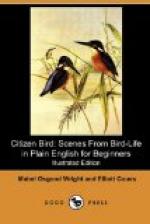“The little round bunch that looks like soft green moss?”
“Yes. Well, that’s the Hummer’s nest!”
“Oh! oh!” cried Dodo, forgetting to whisper, “I see a mite of a tail and a sharp needle beak sticking over the edge!”
This was too much for Mrs. Hummer, who flew off with a whirr like an angry little spinning-wheel—if such a proper Puritan thing is ever angry; and there in the nest were two tiny eggs, like white beans.
“Come back by the fence and watch,” said Joe. “She doesn’t like to leave the nest much when it is toward night.”
“It’s a pity her mate is dead. How lonely she must be!” said Dodo, who had a tender little heart.
“I do not think her mate is dead,” said the Doctor; “he is merely staying away, after a custom of his family. The bird whose nest we see there is called the Ruby-throated Hummingbird, because he has a patch of glittering ruby-red feathers under his chin, at the top of his buttoned-up vest that hardly shows any while shirt-front. He wears a beautiful golden-green dress-coat, with its dark purplish tails deeply forked. His wife looks very much like him, only she has no ruby jewels to wear.
“Bold as this bird is in darting about and chasing larger ones, he is less than four inches long—only about the size of one of the hawk-moths that come out to feed, just as this valiant pygmy lancer leaves the flowers for the night.
“These Hummingbirds live on honey and very small insects, and dread the cold so that they spend the winter southward from Florida. But as soon as real spring warmth comes, they spread over the United States, east of the plains, and north even to the Fur Countries. They are the only kind found in the eastern half of North America, though there are more than a dozen other species in the West, most of them near the Mexican borders of the United States.
“When the Hummers arrive here, early in May, we see the brilliant males darting about—sometimes, I am sorry to say, quarrelling with their rivals and giving shrill cries like the squeaking of young mice. The last of May the dainty nest is made of plant-down and lichen scales. Then the male goes off by himself and sulks. You may see him feeding, but he keeps away from the nest—selfish bird that he is—until the little ones are ready to fly.
“Meanwhile the mother takes all the care and trouble herself, feeding her little Hummers in a peculiar way. She swallows tiny insects, and when they have remained a little while in her crop she opens her beak, into which the young bird puts its own and sucks the softened food, as a baby does milk from its bottle.”
“I was wondering this very morning,” said Joe, “how the old bird was going to feed her young ones when those two eggs hatched, without any mate to help her. I’m real glad you came along to explain it, sir. Somehow the reasons lots of folk give for things aren’t reasonable at all.”




